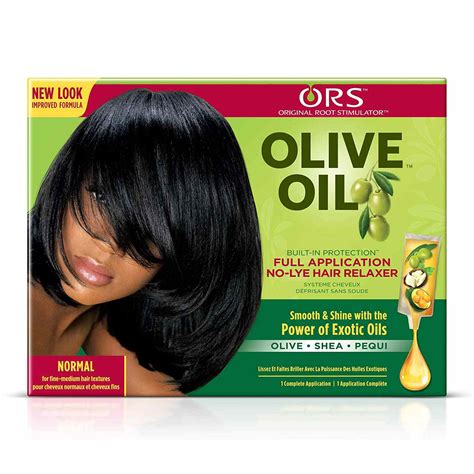Introduction: Embrace the Magic of Curly Hair Relaxers
Curly hair, a blessing for many, can also be a source of frustration when trying to achieve sleek, manageable strands. Enter curly hair relaxers, the transformative solution that has revolutionized the haircare industry. This comprehensive guide delves into the world of curly hair relaxers, empowering you with the knowledge you need to make an informed decision about whether they are right for you.

Types of Curly Hair Relaxers: Understanding the Options
1. Sodium Hydroxide (lye) Relaxers:
– Powerful chemical straighteners that permanently break down hair bonds, resulting in the most dramatic hair straightening effect.
– Can be harsh on the scalp and hair, so professional application is recommended.
2. Calcium Hydroxide (no-lye) Relaxers:
– Gentler than lye relaxers, they gradually weaken hair bonds, providing a more gradual straightening effect.
– Less damaging to the scalp and hair, but may require multiple treatments to achieve desired results.
3. Guanidine Hydroxide Relaxers:
– Long-lasting relaxers that provide a permanent straightening effect.
– Slightly less harsh than lye relaxers, but still require regular touch-ups.
Benefits of Curly Hair Relaxers: Unveiling the Transformative Power
1. Hair Straightening and Smoothing:
– Relaxers chemically alter hair structure, reducing curl and creating sleek, straight strands.
– Ideal for those seeking a low-maintenance, polished look.
2. Enhanced Manageability:
– Reduces tangles and knots, making hair easier to brush, style, and manage.
– Saves time and effort in daily haircare routines.
3. Increased Hair Length:
– Relaxing hair reduces breakage and split ends, promoting hair growth and allowing for longer, healthier strands.
– Enhances the overall appearance and vitality of hair.
Pain Points of Curly Hair Relaxers: Addressing the Challenges
1. Chemical Damage:
– Relaxers contain strong chemicals that can damage hair structure if used improperly.
– Overuse or improper application can lead to weakened, brittle hair.
2. Scalp Irritation:
– Some relaxers, particularly lye relaxers, can cause scalp irritation or burns if not applied correctly.
– Professional application can minimize this risk.
3. Time Commitment:
– Relaxers require regular touch-ups every 6-8 weeks to maintain straightness.
– Can be a time-consuming and expensive process.
Motivations for Using Curly Hair Relaxers: Uncovering the Reasons Why
1. Style Preference:
– Many individuals prefer the sleek, straight look that relaxers provide.
– Aligns with societal beauty standards and personal style choices.
2. Convenience:
– Relaxers offer a low-maintenance solution for managing curly hair.
– Reduces time and effort spent on styling, detangling, and blow-drying.
3. Damage Control:
– Relaxing hair can prevent damage caused by excessive heat styling or mechanical tension.
– Protects hair from breakage and split ends.
Things to Consider Before Relaxing Hair: Essential Factors to Ponder
1. Hair Type and Texture:
– Relaxers are most effective on coarse, tightly coiled hair.
– Fine or damaged hair may be more susceptible to damage.
2. Lifestyle and Maintenance:
– Regular touch-ups are essential to maintain results.
– Be prepared for the time and expense involved in maintaining relaxed hair.
3. Professional Application:
– For optimal results and minimized damage, it is highly recommended to have relaxers applied by a licensed professional hairstylist.
How to Choose the Right Curly Hair Relaxer: A Step-by-Step Guide
1. Determine Hair Texture:
– Consult a professional hairstylist to determine your hair type and porosity.
– This will help you choose the right relaxer strength.
2. Consider Desired Result:
– Decide on the level of hair straightening you desire, from mild to dramatic.
– Different relaxer types offer varying degrees of hair smoothing.
3. Research and Consult:
– Read product reviews and consult with haircare professionals to gather information about different relaxer brands and formulations.
– Seek recommendations based on your specific hair needs.
Safety Precautions for Using Curly Hair Relaxers: Ensuring a Healthy Relaxing Experience
1. Test for Allergies:
– Perform a patch test on a small area of skin before applying relaxer to the entire head.
– This will rule out any potential allergic reactions.
2. Protect the Scalp:
– Apply petroleum jelly or a scalp protector around the hairline to prevent skin irritation.
– Follow the instructions for the specific relaxer being used.
3. Rinse Thoroughly:
– After applying the relaxer, rinse hair thoroughly with warm water to remove all traces of the chemical.
– Neutralizing shampoos can also be used to balance hair pH.
Curly Hair Relaxers: Making an Informed Decision
Curly hair relaxers offer a powerful tool for achieving smoother, straighter hair. However, it is crucial to understand the potential benefits and drawbacks before making a decision. By following the tips and precautions outlined in this guide, you can navigate the world of curly hair relaxers with confidence, empowering yourself to make an informed choice that aligns with your haircare goals.
Additional Resources:
- American Academy of Dermatology: Hair Relaxers
- National Institutes of Health: Hair Relaxers
- International Journal of Women’s Dermatology: Hair Relaxers
Frequently Asked Questions (FAQs)
1. Is it safe to use curly hair relaxers on all hair types?
No, relaxers are most effective on coarse, tightly coiled hair. Fine or damaged hair may be more susceptible to damage.
2. How often should I touch up my relaxed hair?
Regular touch-ups are necessary every 6-8 weeks to maintain straightness.
3. Can I relax my hair at home?
While home relaxer kits are available, it is highly recommended to have relaxers applied by a licensed professional hairstylist for optimal results and minimized damage.
**4. What are the alternative
